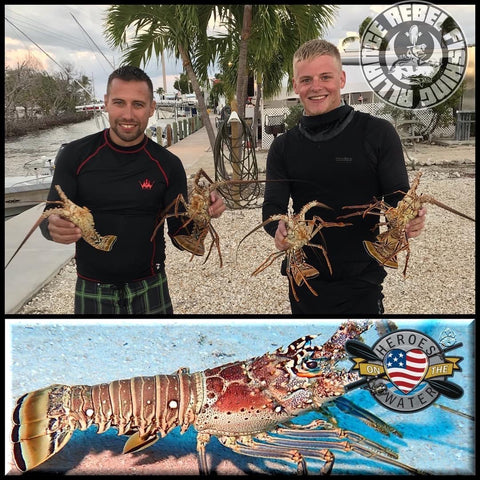
The Caribbean Spiny Lobster - Complete Overview
(Pictured in featured image above: RFA Officer Captain Chris Fanelli of Airborne Outdoors Fishing Charters enjoying some personal time hunting bugs in the Florida Keys!)
The Caribbean Spiny Lobster (Panulirus argus)
There are over 60 species of spiny lobster throughout the world. The spiny lobster habitat is global. While they’re abundant in South Florida, the Bahamas and the Caribbean, they’re also found along the southeastern seaboard of the United States, New Zealand, South Africa and Australia.
Spiny Lobster Award:

(RFA campaign ribbon award for Caribbean Spiny Lobster. Pictured with no devices. Eligible devices include special event devices, night-ops device, captains bars {for RFA Officers}, and member’s personal best designations.
Namesake: Scientific Name: Panulirus argus
They get their name from the forward-facing spines that cover the body, which help to protect them from predators such as octopuses, nurse sharks and stingrays. Depending on where you are, people have different names for spiny lobsters. They’re typically found hiding in coral rock, so they’re often called rock lobsters. The French refer to them as langoutes and in the Caribbean it’s common to hear them called crayfish or crawfish. You’ll also hear a lot of Florida anglers refer to them as bugs or Florida lobster.
Indentification & Characteristics:
Caribbean spiny lobster is a decapod; it has ten legs. It is covered with a spiny exoskeleton including two long antennae that provides it some protection from potential predators. Their long antennae ward off predators not only by looking somewhat intimidating but sounding intimidating as well. Spiny lobster make a “squelching” or “rasp” sound by rubbing a plectrum (an extension off of the base of each antenna) over a file which is located on each side of a plate below the eyes. Hear this sound by clicking here. This transmitted sound can be heard almost 2 miles away in the water. Spiny lobster also have smaller antennules which detect movement and chemicals in the water. They have a reddish brown shell, marked with occasional dark spots and two large, cream-colored spots on the top of the second segment of the tail.
Spiny lobsters may live 15 years or more, but there is uncertainty regarding this estimate due to the difficulty in ageing this species. They can grow up to 15 pounds and 24 inches. Females can reproduce when they reach 2.75 to 3 inches carapace length in the southeastern United States, and 3.6 inches in the Caribbean. Mature Size range: 6” to 2’.

(RFA Members Jason Nicko {pictured left} and Matt Steele {Pictured Right} Holding up a few spiny lobsters caught during an annual Heroes on the Water event in the Florida Keys prior to cleaning and prepping the lobster for dinner)
Spiny lobsters lack the large frontal claws of the American lobster and are instead harvested for their meaty “lobster tail.” However, there is much more meat in each lobster than just the tail. Find out how to properly clean these crustaceans to respect the sacrifice of it’s harvest. Here is a great video from @Fly Navarro’s Fishing Encyclopedia on How to clean a Florida Spiny lobster with Cod & Capers Seafood
Habitat, growth, and helpful facts on lifecycle:
Primarily Spiny Lobster can be found nearshore or inshore in water depths ranging from 2’-200’. Any hard bottom or structure that provides ledges, crevices, and/or depressions and overhangs for the lobsters to hide and seek refuge from predators. Examples of this type of structure include rocks, coral reefs, mangrove roots, shipwrecks, or timber and other structure displaced by hurricanes.
During the day, Caribbean spiny lobsters remain hidden in caves, under ledges, and in crevices on the reef surface. Spiny lobsters are nocturnal carnivores. Individuals are much more active at night and forage along the reef and nearby flats for meals, preying on small snails, crabs, clams, urchins, decaying organic matter, and some plants.
Spiny lobsters grow by molting their hard external shell. As they vacate their old shell, they absorb water, expanding their soft body before the newly exposed shell hardens.
Adults migrate seasonally in single-file lines, known as queues, into deeper water to avoid cold and turbulent water. Here is a great video from @Landshark Outdoors depicting a spiny lobster queue off the east coast of south Florida
Natural Predators of the Caribbean Spiny Lobster include turtles, octopuses, snapper, sharks (especially nurse sharks), stingrays, and grouper (especially Nassau).
Mini-Season (AKA sport season):
Spiny Lobster mini-season in Florida is held for two days only and are the last consecutive Wednesday and Thursday of July each year. This year, the Spiny Lobster diver season is scheduled for July 29th and 30th, 2020.
Regular spiny lobster season is August 6 through March 31. For information on spiny lobster regulations during the sport season and the regular season, visit the FWC’s Divison of Marine Fisheries Management Lobster page.
Regulations of Spiny Lobster in Monroe County (Florida Everglades and Keys):
-
Anyone who is spiny lobstering in the Keys (or anywhere in the state) must have in their possession a Florida recreational saltwater fishing license and a lobster permit.
-
The daily limit for lobsters caught is six (6) per person in or out of the water per day for the Florida Keys and Biscayne National Park in Monroe County.
-
All spiny lobsters kept must be larger than 3” (and must be measured while still in the water).


(RFA member Matt Steele surfaces with a spiny lobster in his net getting ready to transfer to boat earning him his spiny lobster campaign ribbon with Heroes on the Water Device. Matt was helping to feed Veterans participating in a Heroes on the Water Annual event in the Florida Keys in December of 2018. The water is chilly in the Keys during December. Make sure you’re properly suited to stay safe and comfortable)
-
All lobsters added to the daily limit bag must be measured immediately before adding to your bag. If the lobster is undersized, it must be immediately released back into the saltwater or added to your daily catch limit.
-
No separating the tail from the body of any lobster is allowed while on the water.
-
No diving is allowed after dark except during sport season (this includes swimming at or below the water surface).
-
No harvesting or possessing of egg-bearing lobsters belonging to any family of spiny, slipper or furry lobsters. (Caribbean Spiny Lobster Females release between 500,000 and 1.7 million bright-orange eggs each time they spawn. The eggs are carried beneath the female’s tail and hatch after four weeks. They spawn from March through August in the Florida Keys on offshore reefs, and spawn throughout the year in the Caribbean.)
-
No harvesting or attempting to harvest spiny lobsters using any type of device which may puncture, penetrate or crush the shell or flesh of the lobster
-
No trapping lobsters is ever allowed
-
No lobster harvest is allowed in John Pennekamp Coral Reef State Park, Everglades National Park, Dry Tortugas National Park or the designated no-take areas in the Florida Keys National Marine Sanctuary or in the Biscayne Bay/Card Sound Lobster Sanctuary during the two-day Spiny Lobster Season.
Tactics and gear to target Spiny Lobsters in Florida:
Day time tactics:
Recreational Trapping, Spear fishing or gigging for Spiny Lobster is prohibited in Florida. Legal methods of catching Spiny Lobster in Florida include free diving or scuba diving and netting Spiny Lobster by using a “tickle stick” to lure the lobster from their dens and netting them.

(RFA member Jason Nicko getting ready to transfer a netted spiny lobster to the live well for transport back to shore before cleaning and prepping it for dinner!)
Find areas in south Florida or the keys that have hard bottom or structure near by a channel or natural cut. Then simply dive down and check holes and crevices. You can also have divers pulled slowly by boat via tow rope while they are looking down into water searching for rock piles, coral heads, or other structure. You may even get lucky and see antennae sticking out of that structure without having to dive down!
You can order a Danco® Premium Lobster Kit from our store by clicking here

You can also use a lobster snare by starting behind the lobster with the snare ring open and gently pulling or coaxing the lobster forward until you’re sure the ring around the tail then quickly closing the snare by pulling back on the opposite end. We offer 33” snares in Red, White, or Blue on our store or you can order custom lengths as well.
Night-Ops Tactics:Diving below the water surface at night to catch Spiny Lobster is not permitted in Florida. However, wading, or poling the flats to “Bully Net” Spiny Lobster at night is!
Here is a video from @Florida Lobstering How to catch a Forida Lobster at night using a bully net. Stay tuned for a new modular bully net kit coming soon to the RFA store!
